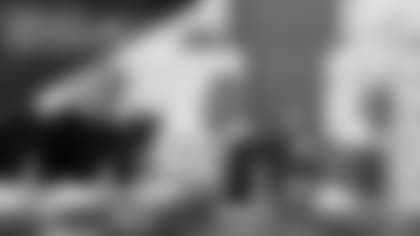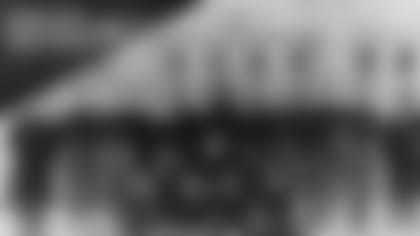Packers team historian Cliff Christl is the author of "The Greatest Story in Sports," the definitive and comprehensive history of 100-plus years of Packers football, set to be published later this fall. In this weekly "Sneak preview" series, Cliff will provide various treats and tidbits from each of the book's 11 chapters.
Here's a glance at Chapter 2. Click here to pre-order the four-volume book set on the Packers Pro Shop website.
1920-1929
Picture(s) Worth 1,000 Words – Much can be learned from photos. The Packers built a fence around their playing field and later two small sections of bleachers in 1920, then tore it all down after the season. Only months later, another somewhat bigger ballpark was built at the same site. The advertising signs tell which was which. On the left, Council Meats was Indian Packing's product when it sponsored the team in 1920. On the right, on the "Canned Meats" sign, Red Crown was Acme's product, but it was also producing Council Meats, as well, in 1921.
A Bite of Text – When the National Football League cut its membership nearly in half before the 1927 season, not only were most teams in its small- and mid-sized cities eliminated, but also what were once flagship franchises.
Robbing the Databank – When the Packers were admitted to what was then the APFA in 1921, they were the second smallest city in the 21-team league. Green Bay's population was 31,017. The smallest city was Tonawanda, N.Y.; population, 10,068 with another 15,482 living in the twin city of North Tonawanda. Tonawanda played one league game and folded. The Packers had played 1,384 league games entering the 2021 season, their 101st in the NFL.
A Secret to Share – No cattle was ever slaughtered at either the Indian Packing plant or Acme Packing plant after the two consolidated. That led, in part, to the Packers cutting ties with Acme within two months, if not mere weeks, after the franchise was granted in the company's name in August 1921.
Memory to Cherish – Rigney Dwyer, a starting end for the Packers in their first two seasons, was working his real job as a railroad switchman when he fell beneath a moving car in the early morning hours a day before Thanksgiving in 1920, and lost an arm and a leg as a result. A benefit game for Dwyer was soon organized and played on December 5. It drew an estimated 4,000 fans and the next day team manager Neil Murphy visited Dwyer in the hospital and presented him with a check for $4,053.02.
Deathbed Moment – The Packers were perpetually in danger of folding in the 1920s and for most of the next two-plus decades. Threats starting in 1920 included lack of a fence around the playing field at Hagemeister Park, which would have prevented the Packers from charging admission; local clergy advocating for the adoption of blue laws that would have outlawed football on Sundays; Acme Packing Co. finding itself $3.65 million in debt – more than $52 million in today's money – within weeks after the franchise was granted in its name; getting booted out of the league following the 1921 season for using college players under assumed names in a game against Racine; the private Green Bay Football Club running out of funds and piling up debts during the 1922 season; and the NFL trimming almost all of its small-town teams in 1927.
If You Were a Fan – Starting in 1921 and until the end of the decade or until radio broadcasts began, fans congregated in different downtown halls or clubhouses on Sunday afternoons to follow the Packers' out-of-town games through a play-by-play service wired by Western Union from the sites of the games. Each play was announced by someone with a megaphone and presented on Playograph and Gridgraph boards.
Shattering Myths – Where to start? Again, some authors have totally botched the team's history throughout the 1920s. Indian Packing sponsored the Packers again in 1920, not Acme as most books have stated. Despite Lambeau's claim, as well as others, of him paying anywhere from $50 to $250 for the Packers' franchise, there's no record of them ever paying a fee; and if they did the established one at the time was $100. No, the Packers didn't get kicked out of the league for using college players under assumed names against the Decatur or Chicago Staleys; nor did George Halas lead the charge to oust them after the 1921 season. He was fighting at the same meeting to maintain his ownership of what would soon be renamed the Chicago Bears. The Marmon Roadster story was preposterous. The 1922 game against Duluth, not Columbus, nearly doomed the Packers, although the Columbus game was also a financial disaster. Although four of the five individuals were heavily involved in keeping the Packers alive during the 1920s, the so-called "Hungry Five" had not yet been named or identified.

Best Player – The Packers signed Verne Lewellen in 1924 and over his nine seasons their record was 79-26-10. He was considered the greatest punter of his time when teams averaged fewer than 10 points a game and punter was arguably the most important position in the game. He also was a standout runner, passer and receiver, and scored an NFL record 51 TDs, which stood for nine years after he retired following the 1932 season.
Overlooked by History – Andrew Turnbull, one of the owners of the Green Bay Press-Gazette, has gotten his due for turning the Packers into a fan-owned team, but what some might not realize is that next to Lambeau, nobody was more instrumental in keeping the team alive through the 1920s.
Among the Chapter's Rare Photos – Photos from the family collections of Neil Murphy, local typewriter salesman and savior of the franchise in 1920; J. Emmett Clair, who was given the original APFA franchise in 1921; Joe Hoeffel, first coach of the Packers when they entered what is now the NFL in 1921; Turnbull, the first president of the non-profit corporation; Mulligan Seroogy, local song-and-dance man who announced the results of out-of-town games at the Playograph gatherings; and King George Kolocheski, local bootlegger who entertained visiting fans, players and others at his inn during Prohibition. Also, the family of Franz Larson provided his collection of Bellevue Park photos and Mark Schneider contributed photos from his large collection of Packers memorabilia.
Biggest Game – The Packers' 1929 victory over the Giants at the Polo Grounds captured the fancy of fans in New York and led to the team's first NFL title. The game was played Nov. 24 and both teams were unbeaten. The Packers were 9-0; the Giants, 8-0-1. The final was 20-6 and 10 of the 11 Packers played all 60 minutes. Lewellen, normally a halfback, had to play quarterback due to an injury to Red Dunn and was involved in most of the game's big plays.
Unsung Hero – In some ways, life was no different in the 1920s than it is today. People balked at building City Stadium because of cost in 1925, but an anonymous benefactor reportedly donated $10,000 to help construct it.
Center of Controversy – There has been no bigger controversy in team history than the one created by the Packers' use of three Notre Dame players, under assumed names and with athletic eligibility remaining, in a non-league game against Racine, played on Dec. 4, 1921. Sportswriter Jack Roberts of the Racine Journal-News wrote about the Packers' ringers the next day. Five days later, the Notre Dame Faculty Board of Athletics learned of the violation by its players during one of its regular meetings.
Only in Green Bay – Team manager Neil Murphy convinced Packers fans to help build a fence around the playing field in Hagemeister Park in 1920 so he could charge them admission to watch the games. Or how about an estimated 20,000 fans turning out in a city with a population of roughly 37,000 to welcome the Packers home after they won their first NFL title in 1929?
Sadly, but True – Not even the NFL can seem to get the Packers' history right. As early as 1942, when it began publishing its annual record manual, it stated in the league's chronological history under the year 1921: "J. E. Clair of Acme Packing Company granted franchise for Green Bay, Wis. (Aug. 27)." That was accurate. J. Emmett Clair was the only representative at the league meeting when Green Bay was awarded its team. In 1987, for whatever reason, the NFL's Official Record & Fact Book, changed the entry in its chronology and stated the franchise was awarded to John Clair, J. Emmett's older brother. John M. was an officer with Acme, but that was inaccurate. "Total Football," the league's official encyclopedia, made the same mistake when it was first published in 1997. Then in 2019, in the "Definitive History of the NFL," published in conjunction with the league's 100th season, the brothers' last name was misspelled. It was spelled "Claire" in the book. What's more, in the "Pro Football Stadiums" appendix in the first edition of "Total Football," almost everything written about the Packers' first two ballparks, Hagemeister and Bellevue, was wrong.
Would You Believe? – The ballpark in Hagemeister Park that served as the Packers' home in their first year in what is now the NFL was built in 12 days in the spring of 1921 for Green Bay's Lake Shore League baseball team and then was expanded by roughly 1,800 seats before the start of the Packers' season.
Rescued from Oblivion – Next to Turnbull, John Kittell probably played the biggest role of anyone in creating the original community-owned corporation in 1923. Kittell was the attorney who signed the original articles of the Green Bay Football Corporation and, thus, was almost certainly the author of them.
A Life of Mystery – Mother Pierre was Green Bay's most renowned madam. At a time when the Packers were drawing mostly sparse crowds at home, she – and others – saw to it that visiting teams enjoyed their stays. "Green Bay in the '20s was the most popular stop in the league," Dan Daly and Bob O'Donnell wrote in their book, "Pro Football Chronicle." "Teams made it a point to schedule several days there. It had a bustling bar scene, and its red-light district in the northeast section was famous."
A Quote to Remember – "Where is Shawano?" That was the question one over-served tuba player who got lost and apparently disoriented asked several Chicago cops as members of the makeshift Lumberjack Band marched to Cubs Park for what is now remembered as the first Packers-Bears game.












